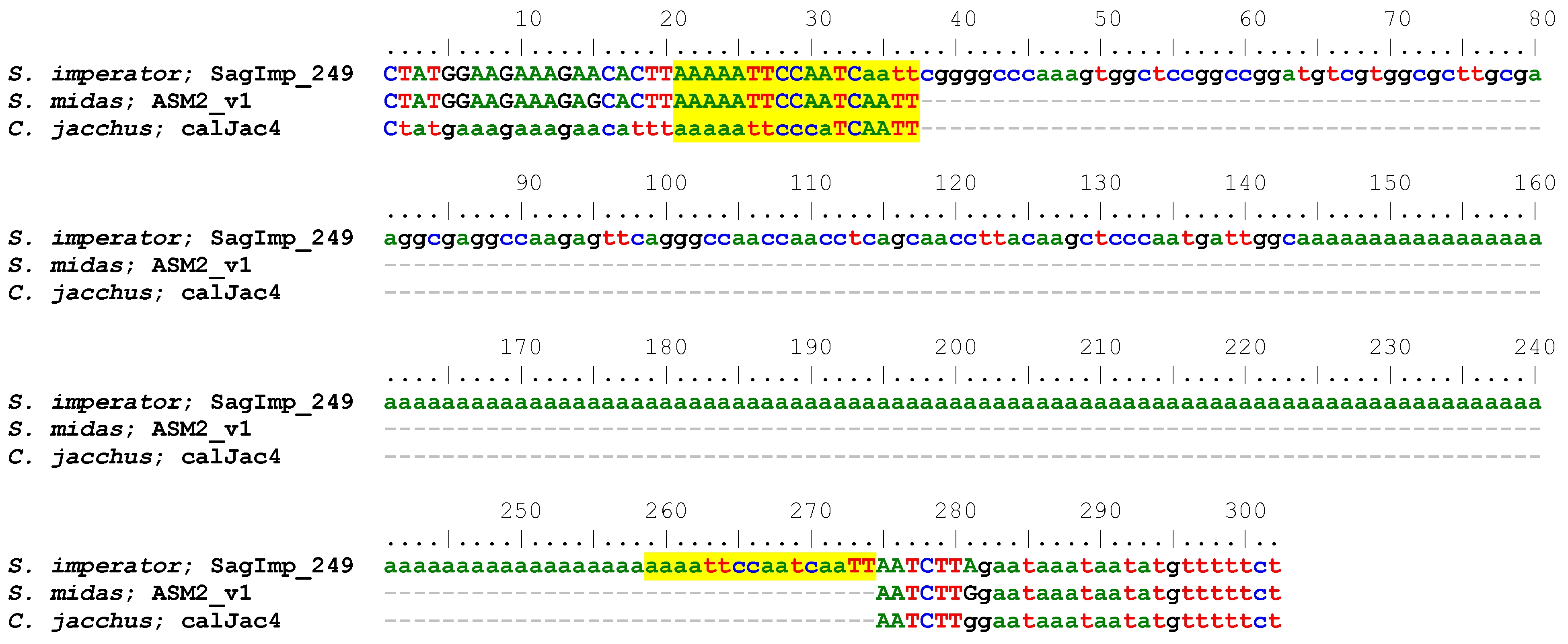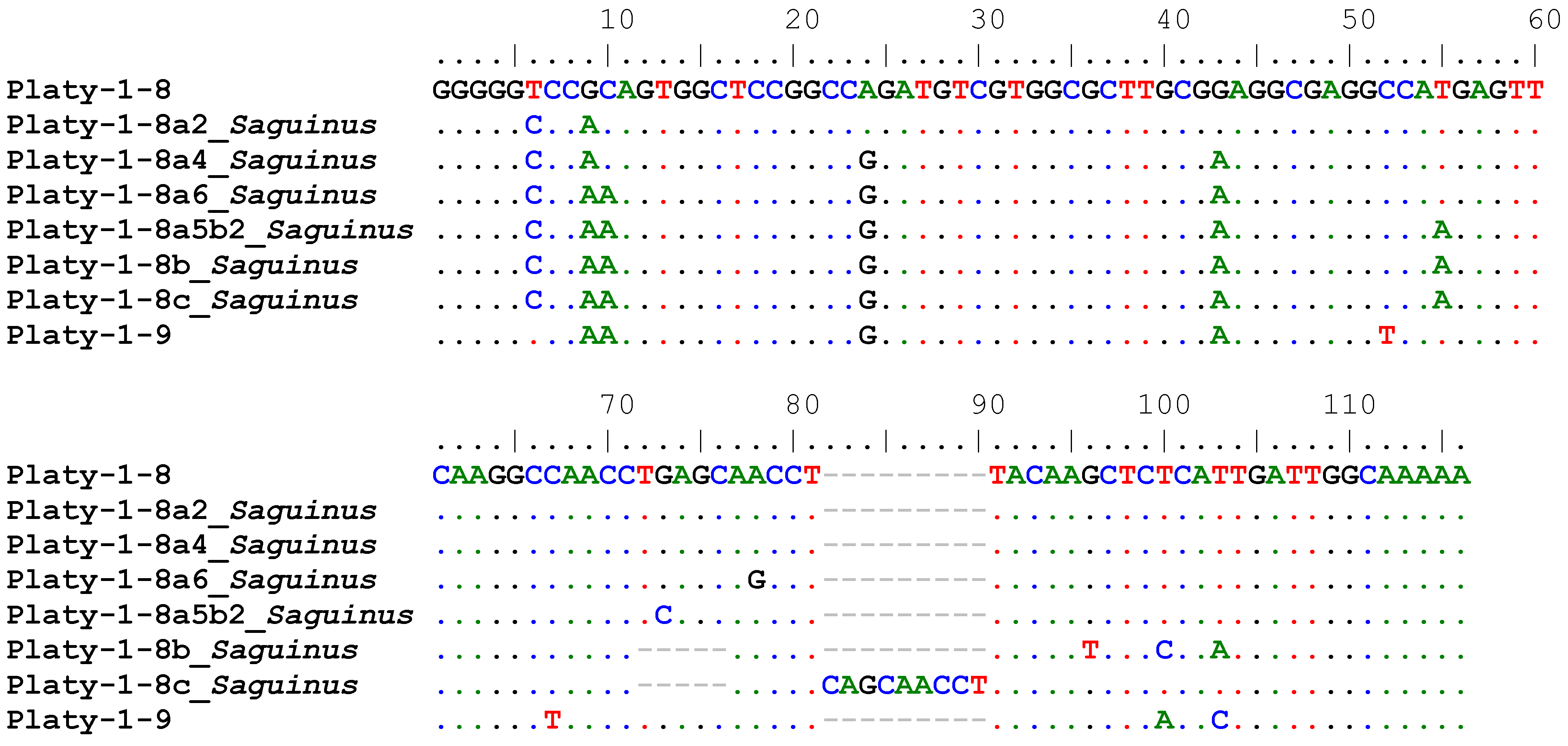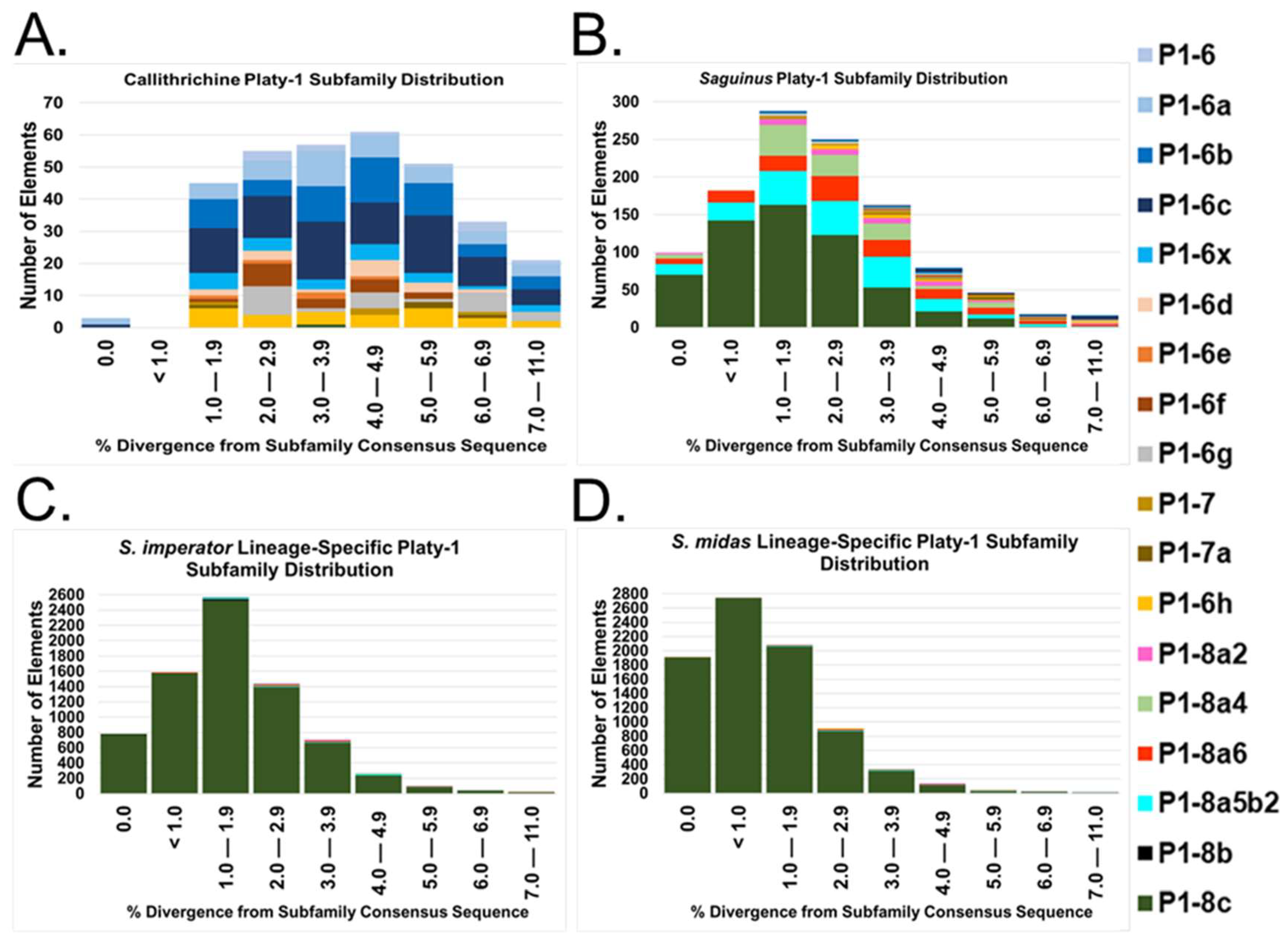Extensive Independent Amplification of Platy-1 Retroposons in Tamarins, Genus Saguinus
Abstract
1. Introduction
2. Materials and Methods
2.1. Full-Length Platy-1 Elements
2.2. Lineage-Specific vs. Shared Platy-1 Elements
2.3. COSEG Analysis of Tamarin Platy-1 Subfamilies
2.4. Neighbor-Joining Tree of Platy-1 Subfamilies
3. Results
3.1. Full-Length Platy-1 Elements
3.2. Lineage-Specific vs. Shared Platy-1 Elements
3.3. Tamarin Platy-1 Radiation and Pristine A-Tails
3.4. COSEG Analysis of Tamarin Platy-1 Subfamilies
4. Discussion
5. Conclusions
Supplementary Materials
Author Contributions
Funding
Institutional Review Board Statement
Informed Consent Statement
Data Availability Statement
Acknowledgments
Conflicts of Interest
References
- Konkel, M.K.; Ullmer, B.; Arceneaux, E.L.; Sanampudi, S.; Brantley, S.A.; Hubley, R.; Smit, A.F.; Batzer, M.A. Discovery of a new repeat family in the Callithrix jacchus genome. Genome Res. 2016, 26, 649–659. [Google Scholar] [CrossRef] [PubMed]
- Worley, K.C.; Warren, W.C.; Rogers, J.; Locke, D.; Muzny, D.M.; Mardis, E.R.; Weinstock, G.M.; Tardif, S.D. The common marmoset genome provides insight into primate biology and evolution. Nat. Genet. 2014, 46, 850–857. [Google Scholar] [CrossRef]
- Dewannieux, M.; Esnault, C.; Heidmann, T. LINE-mediated retrotransposition of marked Alu sequences. Nat. Genet. 2003, 35, 41–48. [Google Scholar] [CrossRef] [PubMed]
- Luan, D.D.; Korman, M.H.; Jakubczak, J.L.; Eickbush, T.H. Reverse transcription of R2Bm RNA is primed by a nick at the chromosomal target site: A mechanism for non-LTR retrotransposition. Cell 1993, 72, 595–605. [Google Scholar] [CrossRef]
- Storer, J.M.; Mierl, J.R.; Brantley, S.A.; Threeton, B.; Sukharutski, Y.; Rewerts, L.C.; St Romain, C.P.; Foreman, M.M.; Baker, J.N.; Walker, J.A.; et al. Amplification Dynamics of Platy-1 Retrotransposons in the Cebidae Platyrrhine Lineage. Genome Biol. Evol. 2019, 11, 1105–1116. [Google Scholar] [CrossRef]
- Garbino, G.S.T.; Martins-Junior, A.M.G. Phenotypic evolution in marmoset and tamarin monkeys (Cebidae, Callitrichinae) and a revised genus-level classification. Mol. Phylogenet Evol. 2018, 118, 156–171. [Google Scholar] [CrossRef]
- Brcko, I.C.; Carneiro, J.; Ruiz-García, M.; Boubli, J.P.; Silva-Júnior, J.S.E.; Farias, I.; Hrbek, T.; Schneider, H.; Sampaio, I. Phylogenetics and an updated taxonomic status of the Tamarins (Callitrichinae, Cebidae). Mol. Phylogenet Evol. 2022, 173, 107504. [Google Scholar] [CrossRef]
- Smit, A.F.A.; Hubley, R.; Green, P. 2013–2015, RepeatMasker Open-4.0. 2015. Available online: http://www.repeatmasker.org (accessed on 14 June 2023).
- Jurka, J.; Kapitonov, V.V.; Pavlicek, A.; Klonowski, P.; Kohany, O.; Walichiewicz, J. Repbase Update, a database of eukaryotic repetitive elements. Cytogenet. Genome Res. 2005, 110, 462–467. [Google Scholar] [CrossRef]
- Kent, W.J. BLAT--the BLAST-like alignment tool. Genome Res. 2002, 12, 656–664. [Google Scholar] [CrossRef]
- Hall, T.A. BioEdit: A user-friendly biological sequence alignment editor and analysis program for Windows 95/98/NT. Nucleic Acids Symp. Ser. 1999, 41, 95–98. [Google Scholar]
- Saitou, N.; Nei, M. The neighbor-joining method: A new method for reconstructing phylogenetic trees. Mol. Biol. Evol. 1987, 4, 406–425. [Google Scholar] [CrossRef] [PubMed]
- Kuraku, S.; Zmasek, C.M.; Nishimura, O.; Katoh, K. aLeaves facilitates on-demand exploration of metazoan gene family trees on MAFFT sequence alignment server with enhanced interactivity. Nucleic Acids Res. 2013, 41, W22–W28. [Google Scholar] [CrossRef] [PubMed]
- Bennett, E.A.; Keller, H.; Mills, R.E.; Schmidt, S.; Moran, J.V.; Weichenrieder, O.; Devine, S.E. Active Alu retrotransposons in the human genome. Genome Res. 2008, 18, 1875–1883. [Google Scholar] [CrossRef] [PubMed]
- Comeaux, M.S.; Roy-Engel, A.M.; Hedges, D.J.; Deininger, P.L. Diverse cis factors controlling Alu retrotransposition: What causes Alu elements to die? Genome Res. 2009, 19, 545–555. [Google Scholar] [CrossRef]
- Roy-Engel, A.M.; Salem, A.H.; Oyeniran, O.O.; Deininger, L.; Hedges, D.J.; Kilroy, G.E.; Batzer, M.A.; Deininger, P.L. Active Alu element “A-tails”: Size does matter. Genome Res. 2002, 12, 1333–1344. [Google Scholar] [CrossRef]
- Cordaux, R.; Batzer, M.A. The impact of retrotransposons on human genome evolution. Nat. Rev. Genet. 2009, 10, 691–703. [Google Scholar] [CrossRef]
- Konkel, M.K.; Batzer, M.A. A mobile threat to genome stability: The impact of non-LTR retrotransposons upon the human genome. Semin. Cancer Biol. 2010, 20, 211–221. [Google Scholar] [CrossRef]
- Harris, R.A.; Tardif, S.D.; Vinar, T.; Wildman, D.E.; Rutherford, J.N.; Rogers, J.; Worley, K.C.; Aagaard, K.M. Evolutionary genetics and implications of small size and twinning in callitrichine primates. Proc. Natl. Acad. Sci. USA 2014, 111, 1467–1472. [Google Scholar] [CrossRef]
- Stanyon, R.; Giusti, D.; Araújo, N.P.; Bigoni, F.; Svartman, M. Chromosome painting of the red-handed tamarin (Saguinus midas) compared to other Callitrichinae monkeys. Genome 2018, 61, 771–776. [Google Scholar] [CrossRef]
- Han, K.; Xing, J.; Wang, H.; Hedges, D.J.; Garber, R.K.; Cordaux, R.; Batzer, M.A. Under the genomic radar: The stealth model of Alu amplification. Genome Res. 2005, 15, 655–664. [Google Scholar] [CrossRef]
- Baker, J.N.; Walker, J.A.; Denham, M.W.; Loupe, C.D., 3rd; Batzer, M.A. Recently integrated Alu insertions in the squirrel monkey (Saimiri) lineage and application for population analyses. Mob. DNA 2018, 9, 9. [Google Scholar] [CrossRef]
- Baker, J.N.; Walker, J.A.; Vanchiere, J.A.; Phillippe, K.R.; St Romain, C.P.; Gonzalez-Quiroga, P.; Denham, M.W.; Mierl, J.R.; Konkel, M.K.; Batzer, M.A. Evolution of Alu Subfamily Structure in the Saimiri Lineage of New World Monkeys. Genome Biol. Evol. 2017, 9, 2365–2376. [Google Scholar] [CrossRef]
- Storer, J.M.; Walker, J.A.; Baker, J.N.; Hossain, S.; Roos, C.; Wheeler, T.J.; Batzer, M.A. Framework of the Alu Subfamily Evolution in the Platyrrhine Three-Family Clade of Cebidae, Callithrichidae, and Aotidae. Genes 2023, 14, 249. [Google Scholar] [CrossRef]
- Storer, J.M.; Walker, J.A.; Rewerts, L.C.; Brown, M.A.; Beckstrom, T.O.; Herke, S.W.; Roos, C.; Batzer, M.A. Owl Monkey Alu Insertion Polymorphisms and Aotus Phylogenetics. Genes. 2022, 13, 2069. [Google Scholar] [CrossRef] [PubMed]
- Storer, J.M.; Walker, J.A.; Rockwell, C.E.; Mores, G.; Beckstrom, T.O.; Orkin, J.D.; Melin, A.D.; Phillips, K.A.; Roos, C.; Batzer, M.A. Recently Integrated Alu Elements in Capuchin Monkeys: A Resource for Cebus/Sapajus Genomics. Genes. 2022, 13, 572. [Google Scholar] [CrossRef]
- Boissinot, S.; Roos, C.; Furano, A.V. Different rates of LINE-1 (L1) retrotransposon amplification and evolution in New World monkeys. J. Mol. Evol. 2004, 58, 122–130. [Google Scholar] [CrossRef]
- Da Cunha, D.B.; Monteiro, E.; Vallinoto, M.; Sampaio, I.; Ferrari, S.F.; Schneider, H. A molecular phylogeny of the tamarins (genus Saguinus) based on five nuclear sequence data from regions containing Alu insertions. Am. J. Phys. Anthropol. 2011, 146, 385–391. [Google Scholar] [CrossRef] [PubMed]
- Konkel, M.K.; Walker, J.A.; Hotard, A.B.; Ranck, M.C.; Fontenot, C.C.; Storer, J.; Stewart, C.; Marth, G.T.; Batzer, M.A. Sequence Analysis and Characterization of Active Human Alu Subfamilies Based on the 1000 Genomes Pilot Project. Genome. Biol. Evol. 2015, 7, 2608–2622. [Google Scholar] [CrossRef] [PubMed]




| Subfamily | P1-1 | P1-2 | P1-2a | P1-2b | P1-3 | P1-5 | P1-4 | P1-4a | P1-4b | P1-4b3 | P1-6 | P1-6a | P1-6b |
| calJac4 | 60 | 23 | 51 | 39 | 25 | 18 | 18 | 19 | 2 | 1 | 14 | 67 | 76 |
| SagImp_v1 | 56 | 27 | 53 | 45 | 22 | 43 | 22 | 20 | 2 | 0 | 11 | 70 | 77 |
| ASM2_v1 | 63 | 19 | 59 | 37 | 21 | 20 | 18 | 20 | 1 | 0 | 16 | 65 | 80 |
| Subfamily | P1-6c | P1-6x | P1-6d | P1-6e | P1-6f | P1-6g | P1-7 | P1-7a | P1-6h | P1-8 | P1-17 | P1-17a | P1-9 |
| calJac4 | 117 | 32 | 13 | 16 | 27 | 26 | 59 | 19 | 51 | 28 | 0 (7) | 0 (1) | 36 |
| SagImp_v1 | 118 | 34 | 19 | 16 | 29 | 101 | 29 | 10 | 59 | 6824 | 0 (11) | 0 (137) | 5818 |
| ASM2_v1 | 127 | 34 | 21 | 10 | 29 | 40 | 28 | 10 | 58 | 5778 | 0 (2) | 0 (4) | 4684 |
| Subfamily | P1-9a | P1-10 | P1-10a | P1-9b | P1-9c | P1-9d | P1-9e | P1-11 | P1-11a | P1-11b | P1-11c | P1-12 | P1-12a |
| calJac4 | 28 | 41 | 16 | 99 | 47 | 34 | 12 | 33 | 16 | 20 | 35 | 19 | 11 |
| SagImp_v1 | 36 | 1 | 0 | 0 | 1 | 0 | 0 | 0 | 0 | 0 | 0 | 0 | 1 |
| ASM2_v1 | 44 | 5 | 1 | 1 | 0 | 0 | 0 | 0 | 0 | 2 | 0 | 0 | 0 |
| Subfamily | P1-12b | P1-12d | P1-12e | P1-12f | P1-12c | P1-13f | P1-13 | P1-13e | P1-15a | P1-13c | P1-14a | P1-14 | P1-14b |
| calJac4 | 71 | 21 | 19 | 19 | 22 | 55 | 4 | 2 | 93 | 53 | 0 | 0 | 6 |
| SagImp_v1 | 0 | 0 | 0 | 0 | 0 | 0 | 0 | 0 | 0 | 0 | 0 | 0 | 0 |
| ASM2_v1 | 0 | 0 | 0 | 0 | 0 | 0 | 0 | 0 | 0 | 0 | 0 | 0 | 1 |
| Subfamily | P1-15 | P1-13g | P1-16 | P1-16a | P1-16b | P1-16c | P1-16d | P1-16e | P1-16f | P1-13b | P1-13a | P1-13d | Total |
| calJac4 | 279 | 50 | 39 | 19 | 23 | 9 | 10 | 9 | 91 | 18 | 33 | 38 | 2231 |
| SagImp_v1 | 0 | 0 | 1 | 0 | 0 | 0 | 0 | 9 | 1 | 0 | 0 | 0 | 13,555 |
| ASM2_v1 | 1 | 0 | 1 | 0 | 0 | 0 | 0 | 1 | 0 | 0 | 0 | 0 | 11,295 |
| Genome | calJac4 | SagImp_v1 | ASM2_v1 |
|---|---|---|---|
| Total Full-length (FL) | 2231 | 13,555 | 11,295 |
| FL w/fasta sequence | 2231 | 10,581 | 11,294 |
| Lineage-Specific (LS) | 1452 | 7511 | 8187 |
| Saguinus-specific (Sag) | n/a | 1169 | 1149 |
| Callithrichidae (Call) | 323 | 325 | 340 |
| S. imperator | S. midas | |||||||
|---|---|---|---|---|---|---|---|---|
| COSEG subfamilies (sf) | LS | % of 7511 | Sag | % of 1169 | LS | % of 8187 | Sag | % of 1149 |
| Platy-1-8a2_Saguinus | 6 | 0.08 | 39 | 3.34 | 1 | 0.01 | 36 | 3.13 |
| Platy-1-8a4_Saguinus | 19 | 0.25 | 94 | 8.04 | 15 | 0.18 | 109 | 9.49 |
| Platy-1-8a6_Saguinus | 63 | 0.84 | 122 | 10.44 | 62 | 0.76 | 127 | 11.05 |
| Platy-1-8a5b2_Saguinus | 50 | 0.67 | 194 | 16.60 | 42 | 0.51 | 195 | 16.97 |
| Platy-1-8b_Saguinus | 29 | 0.39 | 1 | 0.09 | 2 | 0.02 | 0 | 0.00 |
| Platy-1-8c_Saguinus | 7298 | 97.16 | 623 | 53.29 | 8053 | 98.36 | 587 | 51.09 |
| Total assigned to new sf | 7465 | 99.39 | 1073 | 91.79 | 8175 | 99.85 | 1054 | 91.73 |
Disclaimer/Publisher’s Note: The statements, opinions and data contained in all publications are solely those of the individual author(s) and contributor(s) and not of MDPI and/or the editor(s). MDPI and/or the editor(s) disclaim responsibility for any injury to people or property resulting from any ideas, methods, instructions or products referred to in the content. |
© 2023 by the authors. Licensee MDPI, Basel, Switzerland. This article is an open access article distributed under the terms and conditions of the Creative Commons Attribution (CC BY) license (https://creativecommons.org/licenses/by/4.0/).
Share and Cite
Storer, J.M.; Walker, J.A.; Beckstrom, T.O.; Batzer, M.A. Extensive Independent Amplification of Platy-1 Retroposons in Tamarins, Genus Saguinus. Genes 2023, 14, 1436. https://doi.org/10.3390/genes14071436
Storer JM, Walker JA, Beckstrom TO, Batzer MA. Extensive Independent Amplification of Platy-1 Retroposons in Tamarins, Genus Saguinus. Genes. 2023; 14(7):1436. https://doi.org/10.3390/genes14071436
Chicago/Turabian StyleStorer, Jessica M., Jerilyn A. Walker, Thomas O. Beckstrom, and Mark A. Batzer. 2023. "Extensive Independent Amplification of Platy-1 Retroposons in Tamarins, Genus Saguinus" Genes 14, no. 7: 1436. https://doi.org/10.3390/genes14071436
APA StyleStorer, J. M., Walker, J. A., Beckstrom, T. O., & Batzer, M. A. (2023). Extensive Independent Amplification of Platy-1 Retroposons in Tamarins, Genus Saguinus. Genes, 14(7), 1436. https://doi.org/10.3390/genes14071436






